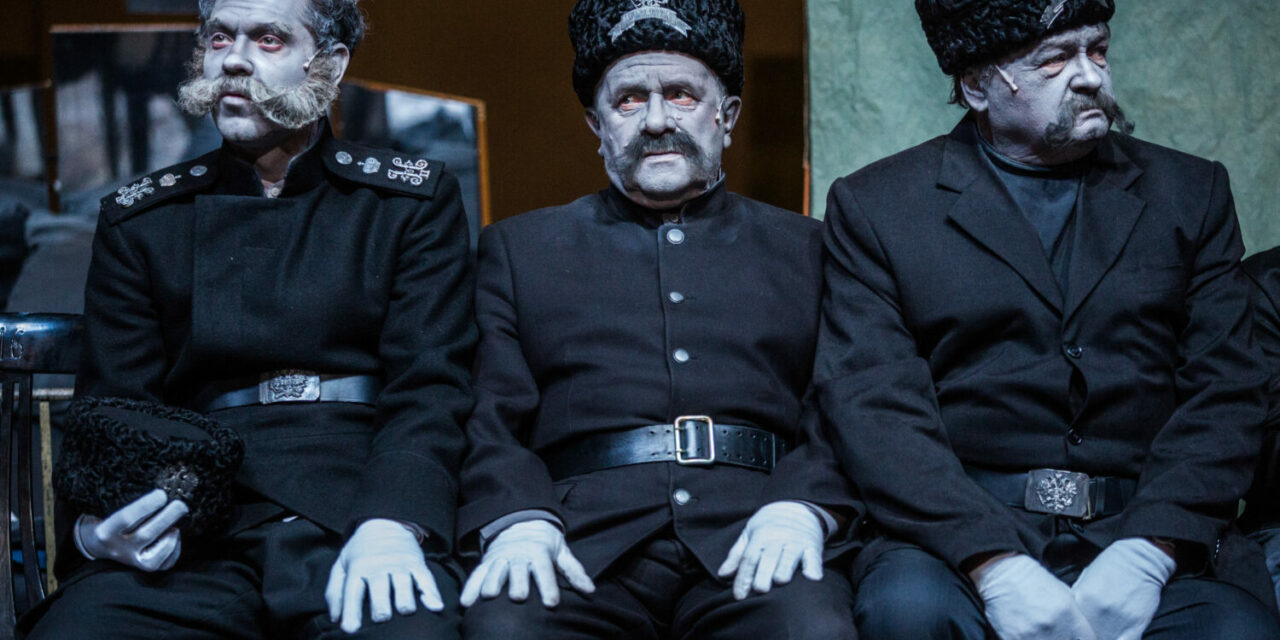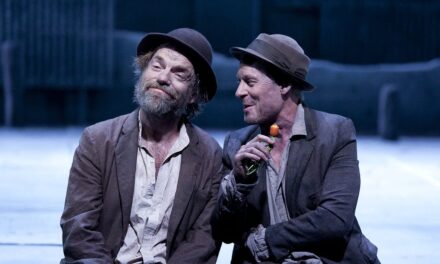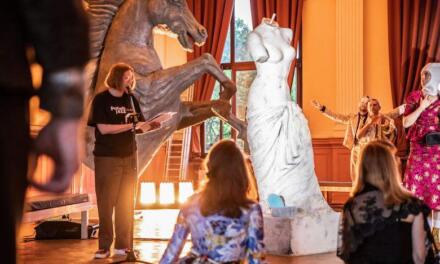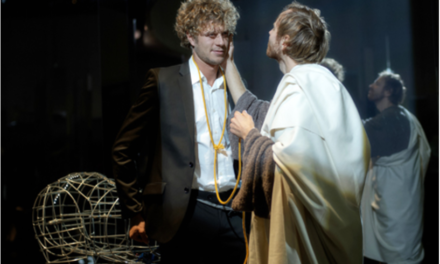In the year 2017 Russian society passed through the jubilee of the Bolshevik Revolution. It would be incorrect to say that this jubilee was celebrated properly. However, the century that came after the Great October made the culture think about the changes in the mindset and the appearance of the country. Two theatre productions created by two most important theatres of Saint Petersburg became the most talked about. These are The Governor by Tovstonogov Bolshoi Drama Theatre and The Optimistic Tragedy by Alexandrinsky Theatre. Both directors, Andrey Moguchy and Victor Ryzhakov, involuntarily created a dilogy using the theatre as an occasion to talk about the century of violence.
An additional production—Keep Forever, made by Andrey Moguchy in Saint-Petersburg Manege—should give to intelligentsia the right aim to overcome the past and current time, a way to become a constant object in the times of political changes.
1.
The Governor is based on a novel of Leonid Andreev written directly after the first Russian Revolution, in 1905. The director, Andrey Moguchy, managed to use the modern technical facilities of the new theatre to inquire objectively into the situation of revolution, where nobody has an opportunity to act another way. Here everyone is guilty but also suffers, is a victim but also the aggressor. Revolution is seen as a dead end, as a dysfunction of the society where suffering is no more to be borne and it is better to die than to live, where the self-preservation instinct doesn’t work anymore and crowds of people are ready to perish for their friends. This objectivity is realized through an interesting method that has never before been used in theatre: There is a kind of box in one of the loges (such as is usually used for a translator in the case of foreign tours) with a pseudo-translator inside who makes a scientific comment on the actions on the stage with a cold voice, as from a documentary. The text comes from the novel by Leonid Andreev. It is his objectivized prose, the dry language of documents, reports, and dispatches. As if there were no more words for any poetical allegorical description of the world.
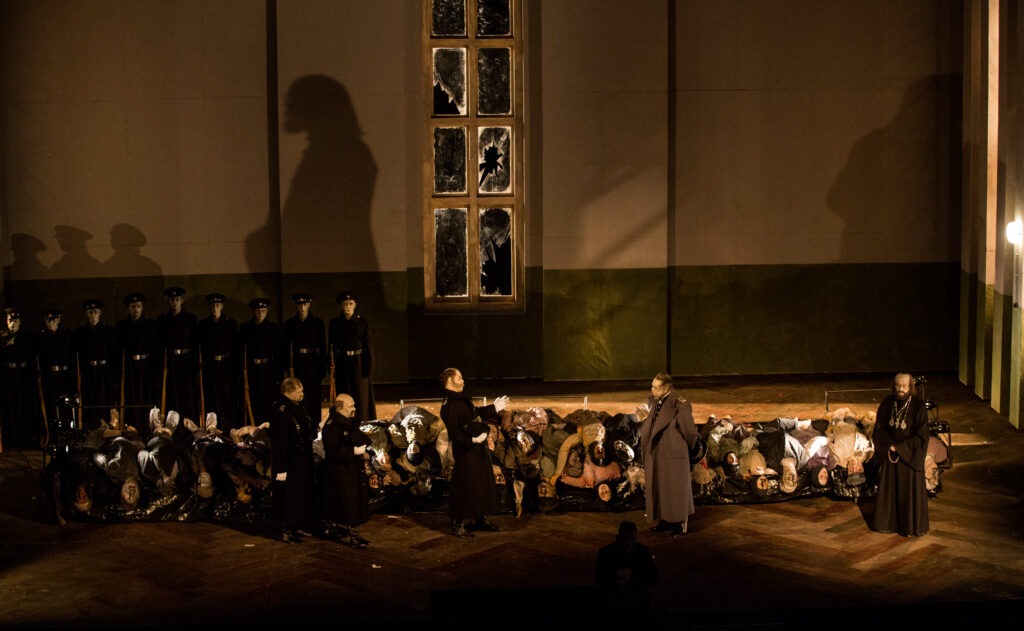
The Governor at Tovstonogov Bolshoi Drama Theatre, St. Petersburg. Photo courtesy of Pavel Rudnev
The Governor shows the background and the roots of the catastrophe of 1917: These are demoralization of the authorities, reduction of the influence of the church, decay of the intelligentsia, and moan of the humiliated and insulted exploited folks whose destiny has not become easier during the last century, who did not get its freedom. There is also the horror of the clash, of the class struggle: The governor gives the order to shoot the peaceful demonstration. Moguchy shows all forty-seven bodies in a very realistic way. There is documented proof that Andreev and Gorky saw the victims of the mass murder after one tragedy in St. Petersburg. This is probably the basis for the precise and powerful vision of the dead as broken dolls used in the production. Moguchy presents the corpses as a line of lying bodies with fractured faces flooded with blood, as a pile of lifeless broken manikins that fall as victims of carelessness, of maggots, of the man in power and his policemen, who have absolutely Brueghel vegetable faces in this production.
Here is also an understanding that violence for violence is the only possibility in this situation but is also the start of the chain of evil. Violence brings only violence, which is why the process of humiliation and terror does not stop until the machine of vendetta, the mechanism, is broken. The revolution is seen as the sum of the tyrannical power of the Romanov House and as a window into the even bloodier century of the power of Soviets at the same time. The revolution of 1917 is a kind of original sin, the root of all our social problems till now.
The theatre works with the subject of despair and fatalisms of the things that happened. The governor has the same vision again and again: The movement of the white kerchief and the shot in the crowd. This movement is somehow separated from the performer: Huge video screens show us a piece of tissue falling down freely. As if it were an accident, a moment of distraction that turned out to be the point of no return. The walls and the ceiling of the governor’s house move themselves, like the shutter of a huge camera. Death is inevitable from the moment of shooting the peaceful demonstration. The society looks becalmed, everybody returns home, but it is just the calm before the storm. The murder of people kills trust in the higher authority and the power of monarchy, and it opens a channel of hidden vengeance. The wait for termless but inevitable death overhangs the governor. The whole town knows that the governor will be killed. He knows it as well and accepts it.
The governor is played by Dmitry Vorobiev as an old man who lost the feeling of reality, who is obsessed with visions and bad dreams. Among other things, he lost the pulse of the time. He is not in the well-shaped nineteenth century anymore. It is a broken apart, discomposed, clumsy new world. The governor feels as a horse in a garage. The movement of the white kerchief becomes a gesture of the powerlessness of an old man in front of fate. The governor is a hostage of his own authority, the dull state machine, the impotence to control even his own life. Andrey Moguchy imagines also the fate of the always drunk demoralized spouse of the governor, a fate that is not written by Andreev. She injects morphine in her leg in front of her own daughter. The governor is already doomed; he bears his guilt inside.

The Governor at Tovstonogov Bolshoi Drama Theatre, St. Petersburg. Photo courtesy of Pavel Rudnev
The modern Russian society is tuned to love all that the revolution tried to destroy: social stratification, elitism, monarchism, bourgeoisie, all the pseudo-Russia that we lost. People do not talk about the breadth of folks suffering close to the luxury of palaces of St. Petersburg, Faberge eggs, and power of the monarchy. However, the scene of the folk procession heading to the governor is the most impressive one on the stage. This mass scene looks like the embodied dream of the Russian intellectual Ivan Karamazov: Covered with soot and wearing rags, the exhausted workers, women with unwashed hair—and the red flag flying above this gray-black mass, the only bright spot in their lives. (Andreev writes in his novel about an injured finger of one worker that is rolled in a dirty oily piece of tissue.) A factory worker cries out that the scream of a saw touching metal is the only sound that he hears. The only heritage he has got from his fathers is an insult: We eat insult, drink insult, and put insult on. Russian theatre has forgotten this intonation during the last decades. Earlier it was everywhere and all of us were tired of this propaganda in the Soviet reality. However, it does not mean that this intonation is not true. Andrey Moguchy, inheriting the Russian cultural tradition, becomes if not a fellow than at least a defender of the folk’s grief.
The main output of the century—demand mercy. No violence can be applied to a person. There are no excuses for violence: Neither state terror, nor police control, nor terror against the state, nor law, nor break of law, nor revenge, nor realization of justice, nor emotional or conceptual motivation. Everyone is worth compassion, everyone is endless lonely and bears his guilt inside of himself. Now the main question of the day is: Is society able to abandon violence?
2.
Now let us talk about the production The Optimistic Tragedy. The Farewell Ball. Its genre is defined by the director as the revolutionary concert based on the play of Vsevolod Vishenvsky.
During the Soviet years, this play (finished in 1933) was a legend, a must stage and must see. It is one of the most important plays about the revolution. It started the trend. It was written by a participant of all the events, one who was intolerant and daring and who tried to put the revolution near the epos, to create a bronze monument for himself and his generation. The witnesses of history (main characters by Vsevolod Vishnevsky) are so terribly (for the modern taste) pathetic, so unceremonious, and so exuding of moral superiority to the audience that the artist of the twenty-first century Victor Ryzhakov is obliged to put off this inappropriate pathos. A lot of text is given away to prostitutes for sailors, these androgynous girls with long legs and holed stockings who are able to break the pathos through their swagger. This deromantization of heroics is important for the dry analysis of the situation.
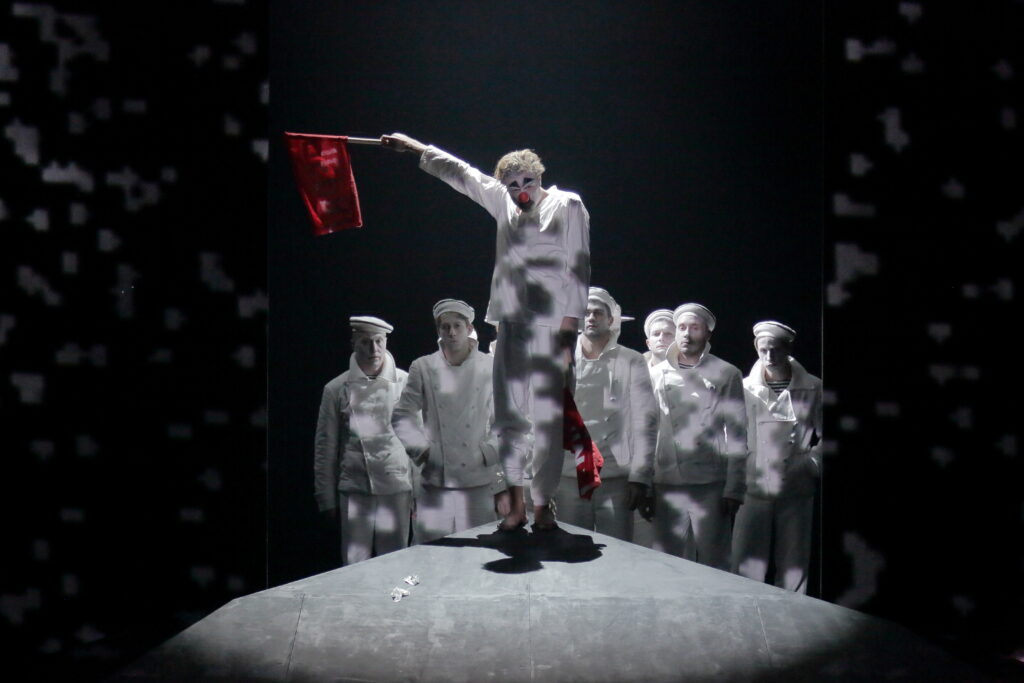
The Optimistic Tragedy at Alexandrinsky Theatre, St. Petersburg. Photo courtesy of Pavel Rudnev
The production of The Optimistic Tragedy during the year of the revolution jubilee transforms into the play’s tribunal. The play aestheticizes the revolution and justifies violence using the tools of art. What are the values of that world, do we still use them? Where has this world, borne by the play, been going? How has it been transforming itself?
The beginning of the performance is a ballet divertissement that demonstrates the memes of the twentieth century: Cruiser Aurora, naked beauties from Art Nouveau cafes, dogs Belka and Strelka in space, the Berlin Wall. Finally, you see American superheroes and start to think about the mutation of the commissar heroics of Vishnevsky. The main character of the play, the revolutionary commissar, is created of Nietzschean philosophy. He gives up the idea of God for the idea of power. Finally, this Übermensch transforms into a superman from fairy-tale blockbusters for children, falls into many chip figures. In the play, the Russian Revolution is recognized as the cause and the start of the whole twentieth century, which turned out to be a bloody wheel rolling down on people but also dramatically moving forward civilization. The play of Vishnevsky is a kind of Pandora’s box that gave a lot of wickedness and traumas to the whole history. It is a fine artistic justification of violence and total ideology.
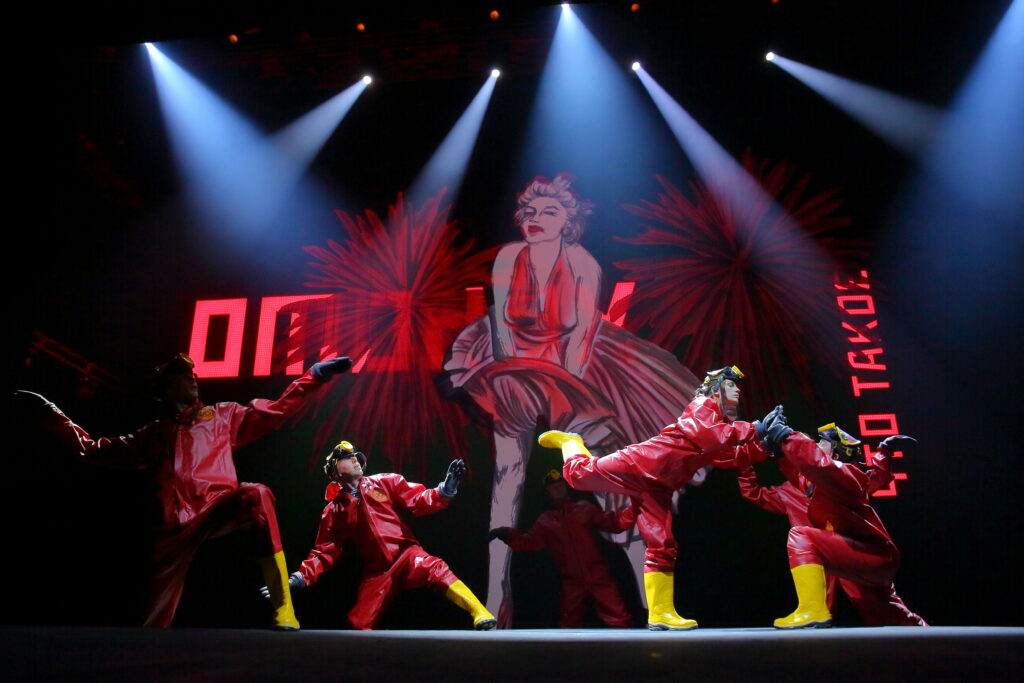
The Optimistic Tragedy at Alexandrinsky Theatre, St. Petersburg. Photo courtesy of Pavel Rudnev
The logic of the revolution that fights for freedom does not function well anymore. Vishnevsky shows the evil chain of anarchists: They kill a sailor for stealing a wallet from an old lady—they kill the old lady because the wallet is found in her pocket—Leader kills officers in prison—Commissar kills Leader. Vishnevsky and all those who trusted him were sure that the bloody wheel stopped in the moment of Leader’s death. The dramatist chose the best time to try to explain logically how Stalin’s regime and discipline put a loop on the revolutionary chaos of Lenin, how the party organized the anarchy and led it in the right direction. However, Victor Ryzhakov observes this problem from the height of the new millennium. It becomes clear that the death of Leader is just the beginning of an era of extirpation that still goes on. The evil chain continues to strike us today. Russian society is transfixed through the revolution. We are built of its blocks, we breathe it, it is our birth trauma.
The brightest parts of the production are the monologues of the revolution victims who call for mercy and humanity.
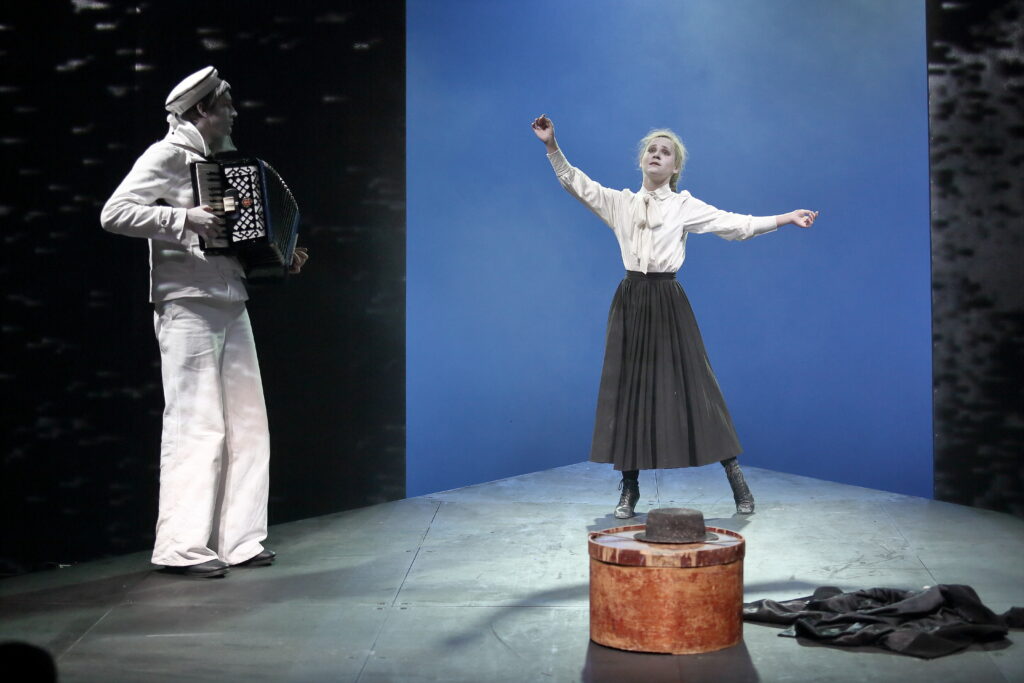
The Optimistic Tragedy at Alexandrinsky Theatre, St. Petersburg. Photo courtesy of Pavel Rudnev
The form of production is a joyful concert. They sing Pink Floyd, Boris Grebenshikov, Christmas carols, street songs, soldiers’ songs about syphilis, political couplets. The Soviet dramatist gave his tragedy a sound of joy. Why should it not sound happy nowadays? Finally, our loud and hysterical kitsch mass culture is also the heritage of the revolution that liberated sexuality and made equal both sexes, what is also shown in The Optimistic Tragedy. It is not important whether one is female or male. What is important is the social class.
People on the stage are singing “I Just Called to Say I Love You,” accompanied by bombardments and explosions of the First (or maybe Third) World War. It just means that thanks to Vishnevsky this is the normality of our world, there is no pure genre anymore. Finally, the best thing one can do during the funeral of civilization is dance.
3.
The third production was made recently in the Manege of St. Petersburg, in the museum. The performance-exhibition with the title Keep Forever is created by director Andrey Moguchy and artist Vera Martynov.
This is an ideal immersive performance: The spectator walks around the exhibition hall and dips into a very special atmosphere, into the given circumstances of the museum and palace, which he perceives with his whole body. He is included in the place and time of action through means emotional, kinetic, and tactile. The exhibition guide is a small girl’s voice (Alisa Freindlich reads the diary of Olya D.) and the history of Russia of the twentieth century itself: The girl grows and goes forward along with the state. It is not only the voice in the earphones that talks; it is also the things around the spectator, the stage properties. The girl starts her story from the beginning of the year 1917. She lives with her parents in Yekaterininskiy Palace. The play ends in our time and moves further to the endless eternity, which is the reason for the idea of continuing to exist.
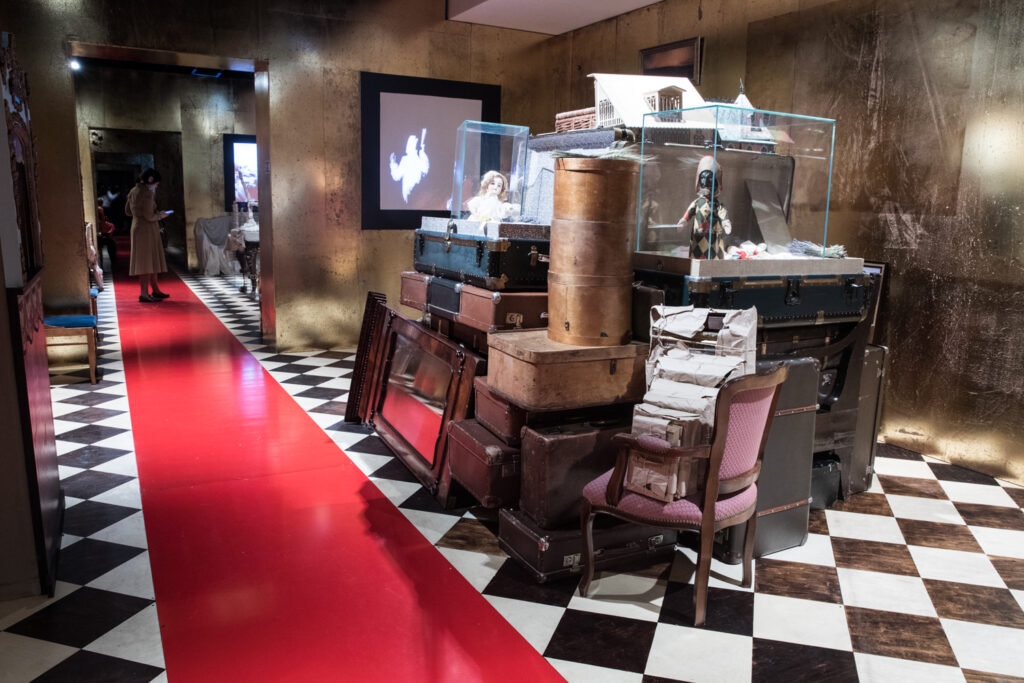
Keep Forever, St. Petersburg Manege. Photo courtesy of Pavel Rudnev
The production by Andrey Moguchy was made for the centennial jubilee of the museums in Petergof, Pavlovsk, Tsarskoe Selo, and Gatchina. Keep Forever is about the mission of the intelligentsia: About the artist, keeper, museum worker, to whom the revolution gave a chance to transform the symbols of the emperor’s power into museum touristic objects. Art starts there, where it starts to be kept. Going through different halls we see the changes in the concept of reality from 1917 to nowadays: The changes of the museum itself, its idea, how it survived during the years under Lenin and Stalin, during the evacuation in the times of war and the siege of Leningrad.
In the middle of the exposition, there is a huge wall. It is the culmination: The cards from the museum’s catalog are put on this wall. It is the list of things, of lost things as well, and the list of the museum workers. The workers become items, a part of the collection. The museum keeps not only the artifacts that survived but also the memories about what is gone. It is also necropolis, cinerarium. Here comes the understanding of the whole idea. Keep Forever is made using modern art methods. Video art is combined with a documentary opera of Vladimir Rannev, with installation, ready-made, aurality, and promenade theatre. All this instrumental power of modern art is used to support the classical heritage, to give a hand not to the modernization but to the idea of keeping and conservation. The most boring and dull part of every museum exposition is that one about museum workers, reconstruction, and restoration. Modern art helps to make this part a sensational one. To pay a debt, to give a feeling of the mission: Modern art can practice only inside a culture that has been kept with care and love.
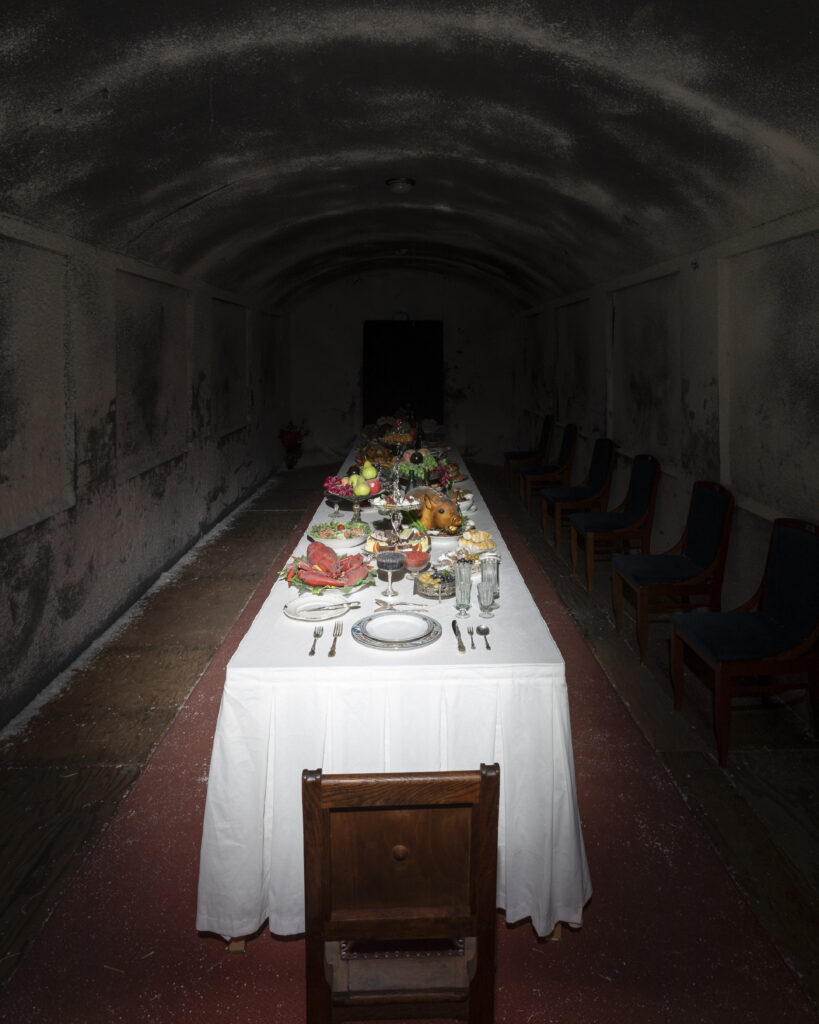
Keep Forever, St. Petersburg Manege (photo courtesy of Pavel Rudnev)
There is another important idea, maybe the most important one. In every hall, you see another concept of a museum, another concept of state and society. Every decade all the conventions between state and culture go through violent metamorphoses; the new “tsar” makes his new rules. I am sure that the creators of this performance understand that the conventions will be changed in the future as well. Every time there comes the question of whether there is any need for culture and which culture is useful. The creators of Keep Forever appeal to us to take it as a norm and to not try to fight it. They see the idea of keeping as the high mission of intelligentsia, the only one that is right and possible under always changing conventions. Culture has only one goal that is opposite to the political one: To collect, to withstand a hit, to further the tradition, to keep the keys from the culture reserve. Nowadays with another change of convention in Putin times, it is especially important to remember the predestination. Someone wrote of the wall with feedback: “Intelligentsia, don’t give up!”

Keep Forever, St. Petersburg Manege (photo courtesy of Pavel Rudnev)
The last hall: After the end of the siege. Instead of palazzos there are ruins, crocks, the last day of Pompeii, downfall, death, and desperation. Bureaucrats say: “Impossible to restore.” These words become a kind of answer to the question of what the culture should do after Auschwitz, our specifically Russian answer. How to write poems after a catastrophe, how to live beyond the despair? It is all you have to do: To write poems. Despair is replaced by the feeling of freedom, of going to zero that is followed by so to say the new founding of Saint Petersburg, by the second wind given to not to spare time and feet. The eternity of keeping is work. To keep forever means to work. Eternity is based on daily work. This hall remembers the metaphor of Petersburg as a city that has an eschatological myth. Dying Petropolis, where fatality lives as presentiment and prophecy.
This post was written by the author in their personal capacity.The opinions expressed in this article are the author’s own and do not reflect the view of The Theatre Times, their staff or collaborators.
This post was written by Pavel Rudnev.
The views expressed here belong to the author and do not necessarily reflect our views and opinions.

